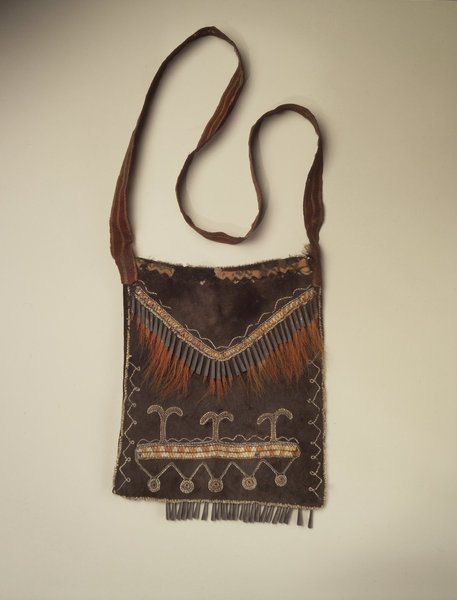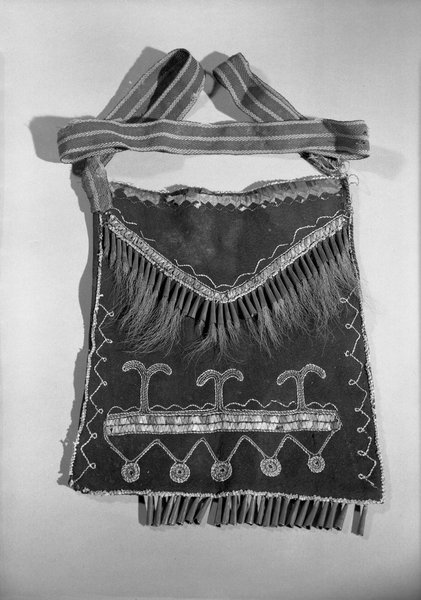Black Pouch Item Number: 50.67.15 from the Brooklyn Museum


Description
This dyed black deerskin pouch is decorated with a false flap, a modified "V" shaped line that is elaborated to seem like the opening of the bag. The edge of this "flap" is bordered with braided quill work in stripes of orange and blue, edged at the top and bottom of the border with thin white lines. A thin, undulating white line has been embroidered above this border. From the bottom of the border, enhancing this illusion of a flap, metal cones filled with reddish deer hair are suspended. Similar cones with deer hair are suspended from the bottom of the bag. The bottom half of the bag is embroidered with quills in a complex of motifs. Three double-curved forms or bifurcating lines are embroidered with thin lines or orange, blue and white. These forms "sprout" from a wider double band of orange and white braided quill work, elaborated with thin outlines in blue and white. The border or groundline for these sprouting forms is surrounded by an irregular, zig-zag outline in white with some blue at bottom. At the base of each of the five resulting points of the zig-zag are five circles, each composed of concentric rings made of quill embroidered lines of white, orange and blue. The ribbon strap of the pouch is now deteriorated, appearing to be maroon with yellowish stripes.
Credit Line
Henry L. Batterman Fund and the Frank Sherman Benson Fund
Label
THE JARVIS COLLECTION
The articles in this case and the adjacent clothing case [see 50.67.6] are some of the earliest and finest Eastern Plains pieces in existence. They were collected by Dr. Nathan Sturges Jarvis, a military surgeon stationed at Fort Snelling, Minnesota, between 1833 and 1836. Most items were made by the Eastern and Middle Dakota (Sioux) or by the peoples of the Red River region, including the Red River Métis, Anishinabe, Plains Cree, and Salteaux. Some of the objects were purchased by Jarvis, and others may have been given to him in exchange for his medical services.
By the early nineteenth century, the growing numbers of white settlers and military personnel—following decades of fur trading—had depleted much of the game on which the Dakota and Red River peoples depended. Indigenous ingenuity in combining trade materials such as cloth, metal, and glass beads with traditional hides, pipestone, and porcupine and bird quills is evident in these objects.
Item History
- Made between 1768 and 1933
What
- Name
- Black Pouch
- Identification Number
- 50.67.15
- Type of Item
- pouch
- Material
- buckskin, porcupine quill, tin, deer hair, ribbon, glass bead and cloth
- Overall
- length 10.0 in, width 8.5 in
Who
- Culture
- Delaware
Where
- Holding Institution
- Brooklyn Museum
When
- Creation Date
- between 1768 and 1933
Other
- Classification
- Carrier